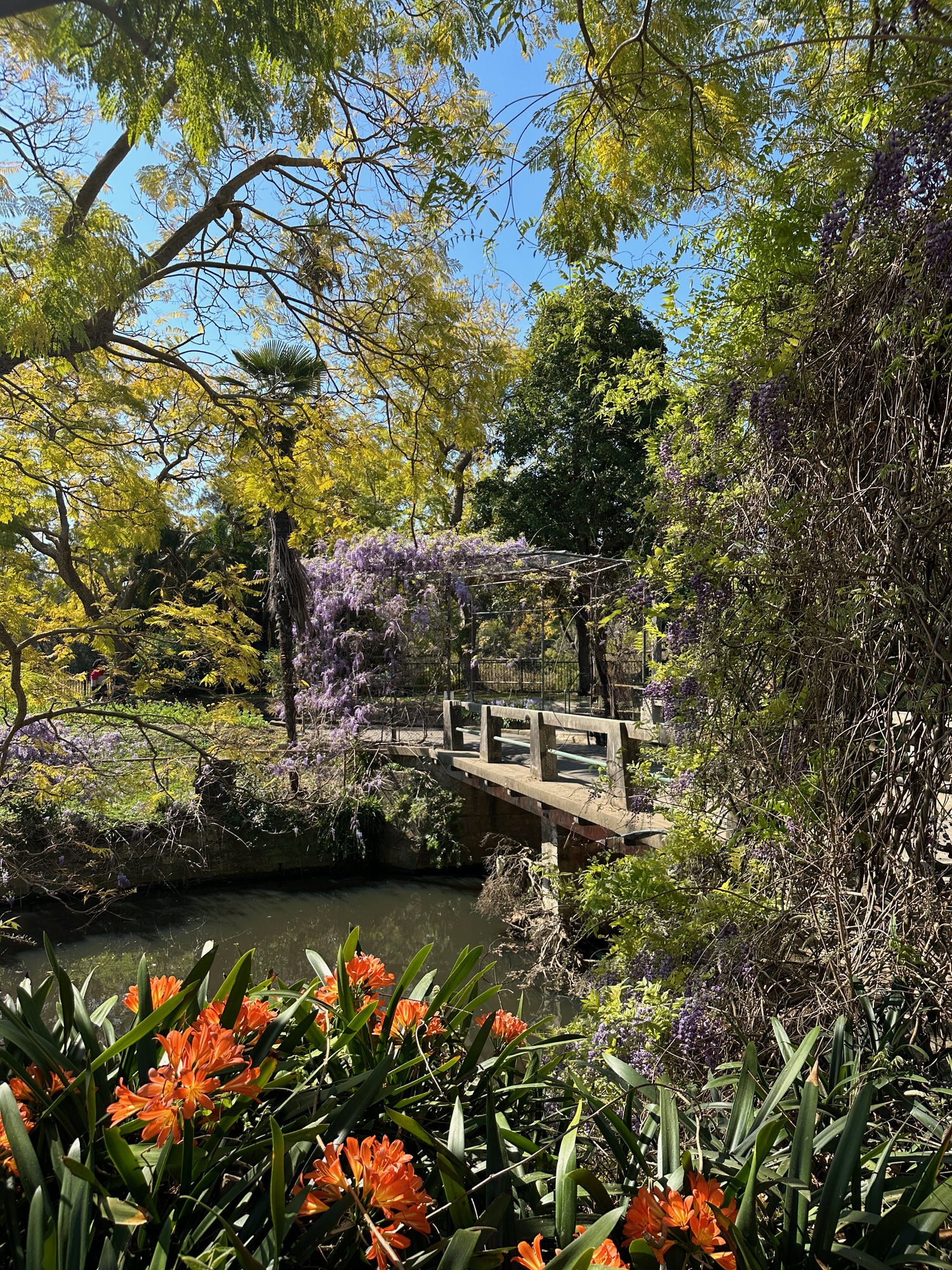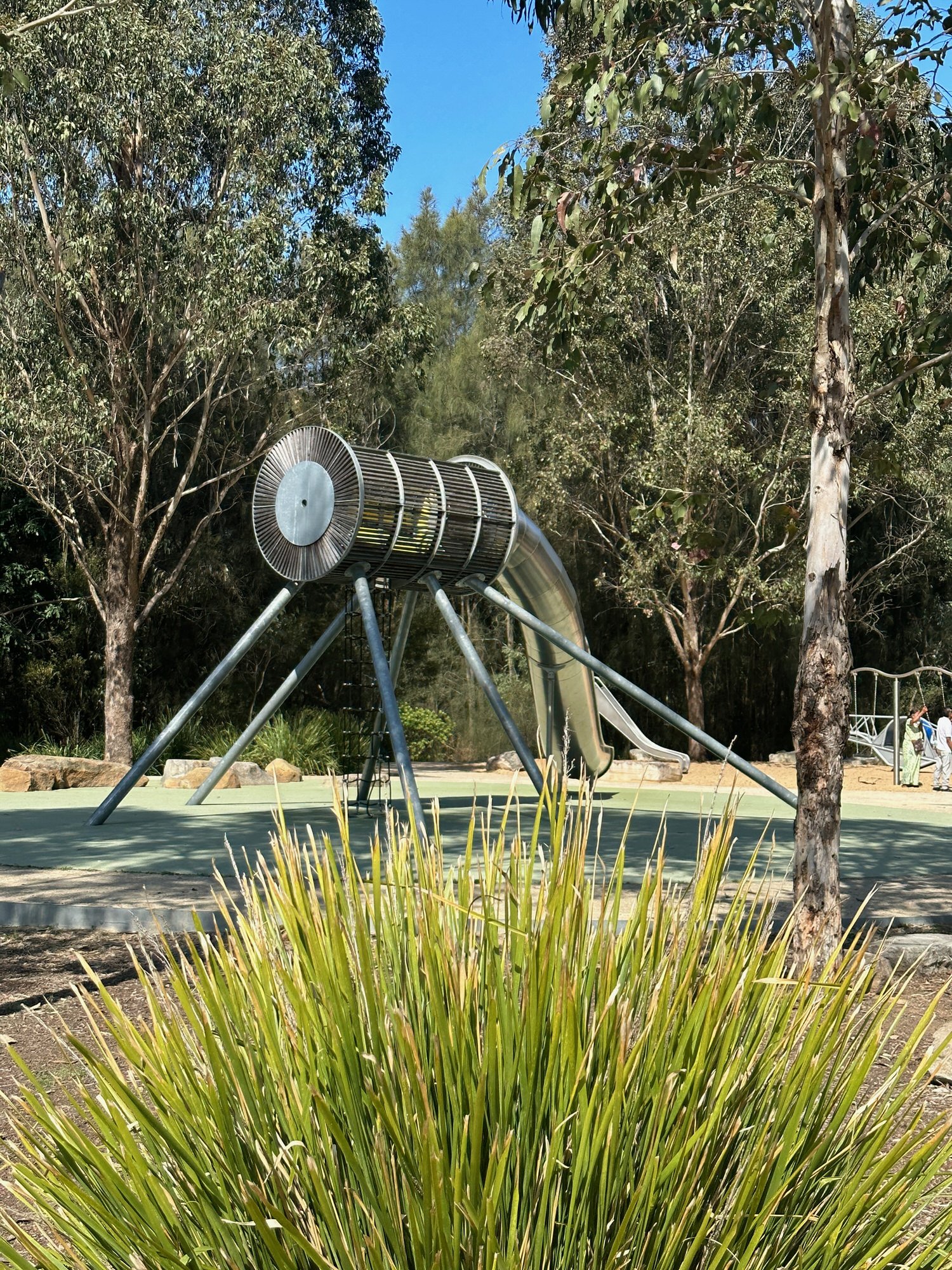Parramatta Park
Parramatta Park is a sprawling green space spread out over 85 hectares incorporating parklands, bushland, event venues, sporting facilities and picnic and play areas. It’s well used by the local community and well worth visiting for those living outside the area.
Parramatta Park lies in the heart of the City of Parramatta in Sydney’s West. On the edge of the CBD, it is close to the central shopping area and easily accessible by car or public transport. There is parking (free and metered) within the park and the train station is about ten minutes walk away. The Parramatta Shuttle Bus is a free service that stops close to the ferry wharf and not far from the station. It runs every 10 minutes, seven days a week.
The Trail around Parramatta Park
The map above outlines a loop around the park on a trail that runs principally alongside the road. You can start at any point and you’ll probably find yourself stepping off the loop path as I did, to explore some of the the park’s history and other highlights.
Highlights & History
Parramatta Park is a delightful blend of natural beauty and rich history. This and its abundant wildlife will be enough to take you off the walking path to discover more.
Parklands and Gardens
Parramatta Park is dominated by native trees and shrubs including ancient Red Gums, Ironbarks and gorgous old Figs. More recent plantings include Lemon-scented gums, planted to add shade and structure to the wide open spaces.
Exotic species in the park include pine trees, English oaks and jacarandas and a large variety of ornamental tress and shrubs can be found in some of the more formal areas of the park including the Rose Garden and outlying Wistaria Gardens.
The Rose Garden, located near the Macquarie Street Gatehouse, boasts one of the largest collections of heritage roses in Australia.
Wistaria Garden
Wistaria Gardens, sits on the edge of the river at the opposite end of the park. It is a local favourite especially in springtime when cherry blossoms and other exotic trees and shrubs add a riot of colour. Truly a sight to see and a pleasant surprise to first-time visitors as i was when I first came across it one September day.
Wildlife
Parramatta Park is home to some 140 species of wildlife. The well-stocked waterways attract lizards, water dragons, long-necked turtles and the occasional snake. But it is the bats and birds that are most prevalent (and most vocal) here.
Flying Foxes
The bats in Parramatta Park are hard to miss and if you don’t immediately see them, you’ll hear their screeches as you get close. There are between 5000 - 10,000 Grey-headed flying-foxes in the park on average, although seasonal influxes can see this number rise to 20,000.
The Parramatta camp of flying foxes has been established here for hundreds of years. They are protected under state and federal legislation and are considered a ‘keystone species’ vital for the long-term health of plants, particularly gum trees.
Locals have a love hate relationship with the flying foxes if my (admittedly small) survey of regular visitors to the park is anything to go by. One person I spoke to said she could sit for hours watching the creatures while another the other spoke of invasion and pestilence! Personally, i find them fascinating.
Birds
According to eBird, there are over one hundred species of birds to be found in Parramatta Park nesting, feeding and foraging in the tall trees, native shrubs and waterways.
In the river and other waterways you’ll find Cormorants, Darters, Herons, Ibis and Moorhens, and plenty of Ducks.
In the surrounding trees look out for large locals like Magpies, Kookaburras, Galahs, Corella’s and Cockatoos.
Some of the smaller birds, less easy to spot include Eastern Rosellas, Spotted Pardalotes and Golden Whistlers.
A Rich History
Parramatta Park has a long and rich history, some of which is visible in buildings and landmarks you’ll pass on your walk.
Original Custodians
Parramatta is one of the earliest Aboriginal cultural heritage sites in Greater Sydney. Artefacts found near this site have been dated back to between 35,000 and 39,000 years. Archaeological sites of this age are very rare.
Evidence found thus far suggests that clans including the Darug settled around the river some 18,000 years ago. Parramatta Park was part of the traditional lands of the Burramattagal people and remains so today. Ancient practices and sustained cultural connection are explained on the Warami Mittigar Aboriginal Cultural Walk.
When the British established a colony in Sydney in 1788, they were quick to see the potential of the Parramatta area and established a farm along the river in the same year. Tragically, with the British came the Smallpox epidemic which decimated the local Darug people.
World Heritage
Old Government House
Government House was one of two main command posts for the convict system in NSW, almost from the get go.
A home for the Governor of the colony was first built on these parklands in 1790. Just a few years later it was replaced by this more substantial two storey home (and outbuildings) which remain. These structures are listed. along with other Australian convict sites, on the UNESCO World Heritage Register.
The two-storey convict-built, Georgian style building features a Classical timber portico (attributed to convict architect Francis Greenway), and contains an important collection of original colonial furniture.
Government House is open Thursday to Sunday and guided tours are available. Find out more or book tickets here.
Other colonial buildings in the park include the Officers' Quarters (at the rear of Government House), Governor Brisbane's bath house and the Governor's Dairy.
The Dairy Cottage built between 1796 and 1805 by ex-convict George Salter, is a good example of early Australian rural architecture. The adjacent Rangers Cottage was built around 1870.
Both buildings are small and somewhat fragile so group tours and numbers on them are limited. You can take yourself on a self-guided tour of the Dairy and Rangers Cottages via the Google Arts & Culture platform or take a virtual tour.
Among other monuments and landmarks you’ll find in the park are the obelisk marking the site of the astronomical observatory founded here on the 2nd May 1824 by the Governor Sir Thomas Brisbane, and the Tudor style Gate House at the park’s George St entrance, erected in 1855.
If you’re interested in the history of the area and want to learn more, download this guide from Parramatta Council. It has a lot of information about historically significant monuments and sites in the park as well as a suggested route for exploring them.
Playgounds and Picnics
Playgrounds
Parramatta Park has two great playgrounds.
The Paperbark Playground near the George Street Gatehouse, is ideal for children and toddlers. It features the latest in playground equipment as well as traditional favourites like swings and a carousel which kids with varied mobility, including wheelchair users, can enjoy. The centre piece is an ‘explorer dome’ – a huge maze made of nets, ropes, ladders and tubes that older children can climb through and balance on.
Domain Creek Playground, on the Westmead side of the Park is spread out over a large area and it too is suitable for children all ages. It has a flying fox, slides, swings, trampolines, a water pump, sand diggers and more.
Picnic Areas
Parramatta Park is a geat place for a picnic set up informally on the grass by the riverside or at one of the many seating areas scattered around the park. There are several small picnic shelters and barbecues available for use, free of charge, on a first come, first served basis. The larger shelters (7 in total) can be booked for parties and other large gatherings.
If you haven’t brought your own picnic you can grab a bite at the cafe near the Gatehouse. For a more formal sit-down lunch try Misc Cafe/Restaurant located near The Dairy in the centre of the park. (A take-away menu for Misc is planned but not yet available, at time of writing).
In the Area
Other walks
If you’re looking to explore this area of Sydney further The Parramatta Lake Trail is another great walk not far from here. More of a bush walk, the trail (or trails, as there are options) wind around Lake Parramatta Reserve, past a dam and swimming hole and through tracts of beautiful bushland.
And just twenty minutes drive from Parramatta Park is the Bicentennial Park Loop Walk, another verdant and varied walk in the park.
More history
If you’re into history, there’s plenty more to explore in the Parramatta area. Here are a few suggestions.
Just a short walk from the north end of the park is the Parramatta Female Factory, a colonial workhouse, hospital and prison now over 200 years old.
Less than 30 minutes walk from the main George St entrance to the park is Experiment Farm Cottage, once home to first fleet convict, James Ruse. Ruse was awarded Australia’s first convict land grant in 1789 and tasked with proving that self-sufficiency was possible in the early colony, near to starving at the time. According to the National Trust which manages the property, Ruse’s successful farming of the 30-acre site “turned the experiment of Experiment Farm into the stuff of legend”.
Five minutes walk from Experiment Farm is Elizabeth Farm, Australia’s oldest surviving European dwelling. Built in 1793 for John and Elizabeth Macarthur and their growing family, Elizabeth Farm today is an immersive museum.


























